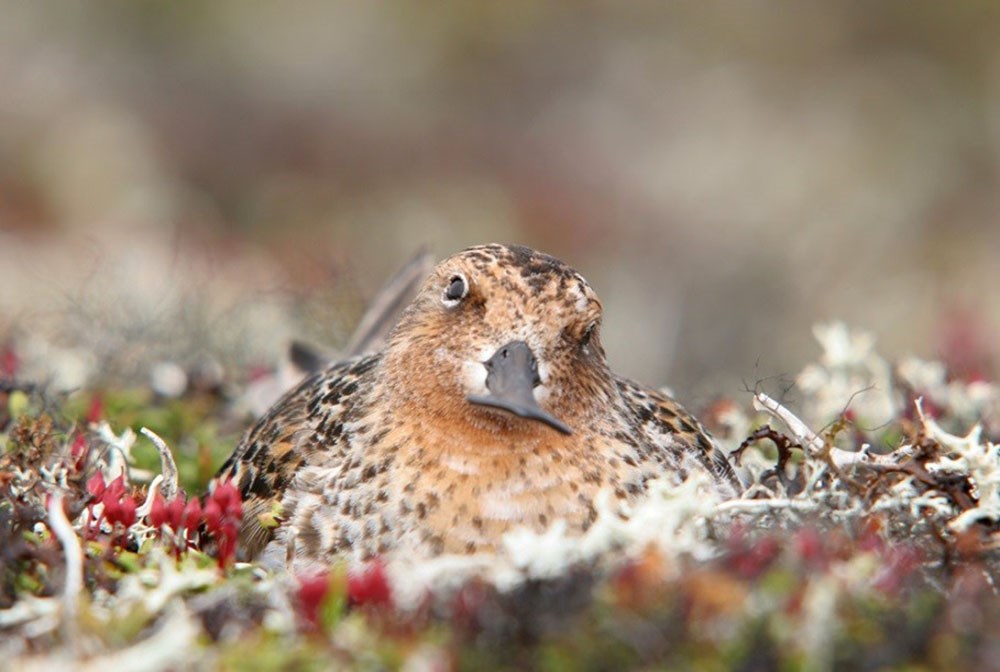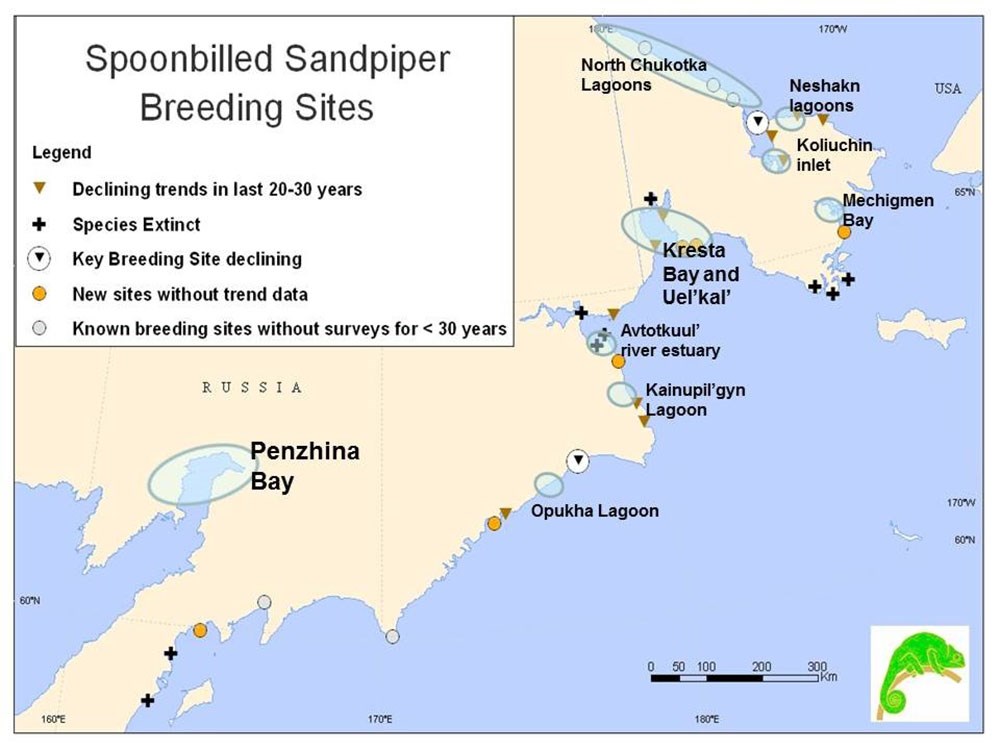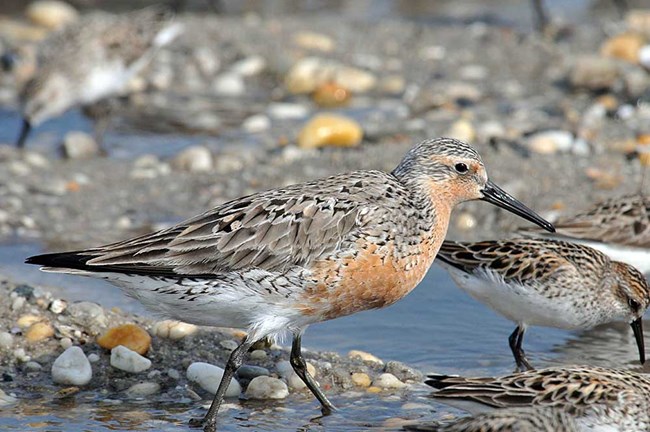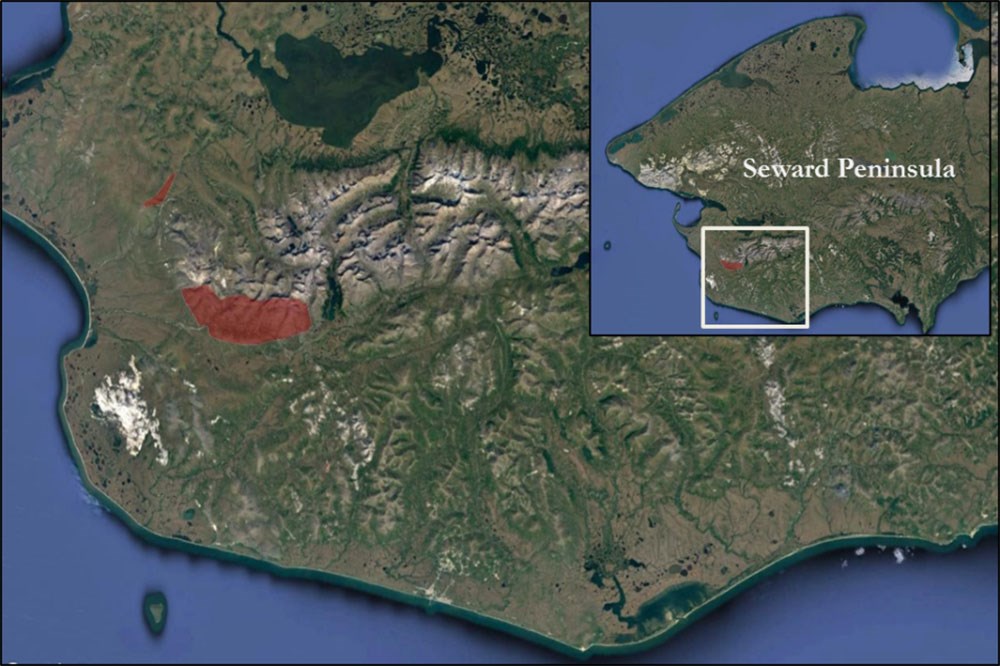Part of a series of articles titled Alaska Park Science - Volume 20, Issue 2. Beringia: A Shared Heritage.
Article • Alaska Park Science - Volume 20, Issue 2. Beringia: A Shared Heritage
Moving the Needle: Enhancing the Conservation of Iconic Shorebird Species of the Beringia Region

Photo courtesy of Iosif Kaurov
The Beringia region of the Arctic and Subarctic supports a disproportionate amount of global nesting shorebirds abundance (Bart et al. 2013) and diversity (Gill et al. 1994). Arctic Alaska is particularly important, providing habitat for nearly half (49%) of all shorebirds breeding in North America (Andres et al. 2012).
Unfortunately, many shorebird populations throughout the world are declining. Shorebirds migrating along the East Asian-Australasian Flyway (EAAF), of which Beringia is part, are perhaps declining at the highest rates (Szabo et al. 2016). Shorebirds face intense pressure from habitat loss and degradation, human disturbance, illegal and unsustainable legal harvest, increasing predator numbers, disease, and contaminants throughout their annual life cycle (Butler et al. 2004, Johnston et al. 2015, Pearce-Higgins et al. 2017). Even within the relatively pristine Arctic, shorebirds face increasing resource development, pollution, and other changes in habitat and the timing of life cycle events (Perkins et al. 2016, Wauchope et al. 2016, Saalfeld and Lanctot 2017, Kwon et al. 2019).
Increasingly, federal, state, and private organiza-tions have recognized that shorebirds, as well as other waterbirds, represent a shared international resource worth conserving. This realization has led to several international agreements and designations that seek to conserve, and where possible, manage human impacts on shorebirds throughout their annual cycles (e.g., Boere et al. 2006, Johnston et al. 2015). Our ability to manage these species is limited by a lack of sufficiently detailed, scientifically rigorous, and spatially comprehensive population assessments and demographic data. Our study, planned to begin in 2022 will focus on habitat needs and demographics for two shorebirds, the spoon-billed sandpiper (Calidris pygmaea) and a subspecies of red knot (Calidris canutus roselaari). These two populations breed only in Beringia and their critical conservation status reflects existing threats in their respective flyways. Hopefully, our research will identify critical habitat components and demographic information for both species that will help in future management.
Spoon-billed Sandpiper
The spoon-billed sandpiper (SBS) is a critically endangered species and is listed in the Russian Red Data Book, an evaluation of the conservation status of Russian birds (Tomkovich 2001). The species breeds in Far East Russia and migrates along the EAAF to winter in Southeast Asia. This species is at the cusp of extinction with fewer than 725 individuals, and only about 200 pairs are thought to breed, principally in the northeast Arctic and subarctic zones of Chukotka and Kamchatka, Russia (Zöckler et al. 2010, Clark et al. 2018). Dramatic declines (as much as 50%) have been documented during the past 30 years at all breeding concentrations where repeat counts were conducted (Figure 1; Zöckler et al. 2010). Unfortunately, no information is available on where 75% of the SBS breed. One of the few known breeding sites for the SBS is near the village of Meinypil’gyno in Chukotka, Russia, whereabout fewer than 13 pairs are thought to breed. The other known breeding sites have only a handful of pairs and most have not been visited for several decades. It is thought that the species might have also previously bred in Alaska, but there are no recent records (Saalfeld et al. 2020).

Birds Russia/Evgeny Syroechkovskiy
Since 2001, BirdsRussia, a Russian non-governmental organization, has been monitoring SBS at Meinypil’gyno. In 2012, this group, together with the Wildfowl & Wetlands Trust (WWT), Royal Society for the Protection of Birds, and others began a program that involves collecting and incubating eggs, raising chicks in a large outdoor aviary with minimal human interference, and then soft releasing them (into an enclosed outdoor pen) at fledging. The collection of eggs allows birds to renest and avoids heavy predation of wild eggs and chicks. Efforts to date have yielded about five times more birds fledged per clutch than would otherwise have happened. BirdsRussia and WWT also collected eggs in 2011 and 2012 to establish the first and only captive breeding program for the species. In addition, BirdsRussia is conducting surveys at different locations of the Chukotka and Kamchatka coasts in an attempt to find remaining breeding grounds. This effort has discovered several new locations with small numbers of birds and also documented the disappearance of others. Many sites remain to be surveyed, but most are difficult to reach. Knowing where the key breeding areas are is the first step in protecting them because we can conserve the habitat they depend on. Public outreach and awareness programs are also an important component in the conservation of endangered species. The Meinypil’gyno site visits conducted by BirdsRussia have led to the soon finalized first shorebird-based nature park in Russia, called “The Land of Spoon-billed Sandpiper.”

USFWS/Greg Breese
Red Knot
There are six subspecies of red knot that breed throughout the circumpolar Arctic (Figure 2). The roselaari subspecies (hereafter red knot) breeds in northwestern Alaska and Wrangel Island, Russia, and migrates along the Pacific Flyway of North America to reach nonbreeding/wintering grounds in California and Mexico. The red knot is designated as endangered by Mexico’s federal government, threatened in Canada, and is listed by the U.S. Fish and Wildlife Service (USFWS) as a species of High Conservation Concern and a Tier 1 Priority Species within the U.S. With an estimated population size of 22,000 individuals (Lyons et al. 2015), the roselaari subspecies of the red knot is one of the rarest shorebirds known to breed in North America (Andres et al. 2012). Declines have been documented at stopover sites in Washington (Buchanan et al. 2010), and there is evidence that the Wrangel Island, Russia breeding population has declined since the 1990s (Tomkovich and Dondua 2008).

Much of the focus on this subspecies in recent years has been on determining the migration routes and important nonbreeding sites. Indeed, identifying autumn migration sites used in preparation for non-stop flights to wintering areas was identified as a critical information need. Ongoing work will also help unravel recent genetic findings that suggest that roselaari is actually two subspecies—one that breeds in northwestern Alaska and the other on Wrangel Island in Russia. A goal of this current study is to determine if there are actually two subspecies. If confirmed, then these two subspecies will be even rarer and in need of even more conservation action.
The next most crucial information need identified by the red knot research community is to generate demographic data that can identify whether factors such as predation on the breeding grounds are limiting population growth. Also, it is critical to determine where in the annual cycle the birds are suffering the highest mortality. Such information is essential for monitoring the roselaari subspecies but can also inform population models of the five other subspecies where these data are more difficult or impossible to collect. With this goal in mind, the USFWS initiated a breeding study along the road system of the Seward Peninsula, Alaska in 2010 (Figure 3). This study area represents the only location across the Arctic where breeding red knots can be investigated in sufficient numbers at a reasonable cost. Research effort has varied between 2010 and now due to intermittent funding dependence on grants, but some data exist for each year. Adult survival estimates from breeding areas in Alaska will be combined with survival estimates modeled from resighting birds at wintering and stopover sites along the flyway (e.g., Guerrero Negro and Alto Golfo, Mexico and Grays Harbor, Washington). Thus, it will be possible to partition annual survival estimates into seasonal estimates (i.e., breeding, wintering, and migration) to determine when disproportionately high mortality rates may occur. Our work proposed here and starting soon should help to provide some of the information needed to conserve these two iconic Beringia species and the resources upon which they depend.

USFWS/Jim Johnson
References
Andres, B. A., P. A. Smith, R. I. G. Morrison, C. L. Gratto-Trevor, S. C. Brown, and C. A. Friis. 2012.
Population estimates of North American shorebirds, 2012. Wader Study Group Bulletin 119: 178-194.
Bart, J., R. M. Platte, B. Andres, S. Brown, J. A. Johnson, and W. Larned. 2013.
Importance of the National Petroleum Reserve-Alaska for aquatic birds. Conservation Biology 27: 1304-1312.
Boere, G. C., C. A. Galbraith, and D. A. Stroud, eds. 2006.
Waterbirds Around the World. The Stationery Office, Edinburgh.
Buchanan, J. B., L. J. Salzer, G. E. Hayes, G. Schirato, and G. J. Wiles. 2010.
Red Knot Calidris canutus migration at Grays Harbor and Willapa Bay, Washington: Spring 2009. Wader Study Group Bulletin 117: 41-45.
Butler, R. W., R. C. Ydenberg, G. D. Donaldson, and S. Brown. 2004.
Hypotheses to explain census declines in North American shorebirds. Shorebird Research Group of the Americas Report 1.
Clark, N. A., G. Q. A. Anderson, J. Li, E. E. Syroechkovskiy, P. S. Tomkovich, C. Zöckler, R. Lee, and R. E. Green. 2018.
First formal estimate of the world population of the Critically Endangered spoon-billed sandpiper Calidris pygmaea. Oryx 52: 137-146.
Gill, R. E. 1994.
Alaska shorebirds: Status and conservation measures at a terminus of the East Asian-Australasian Flyway. Pages 21-42 In Conservation of Migratory Waterbirds and their Wetland Habitats in the East Asian-Australasian Flyway (D. R. Wells and T. Mundkur, editors). Proceedings of an International Workshop, Kushiro, Japan, 28 Nov – 3 Dec 1994. Wetlands International-Asia Pacific, Juala Lumpur, Publication No. 116, and International Waterfowl and Wetlands Research Bureau – Japan Committee, Tokyo. 304 pp.
Johnston, V., E. Syroechkovskiy, N. Crockford, R. B. Lanctot, S. Millington, R. Clay, G. Donaldson, M. Ekker, G. Gilchrist, A. Black, and R. Crawford. 2015.
Arctic Migratory Birds Initiative (AMBI): Workplan 2015-2019. CAFF Strategies Series No. 6. Conservation of Arctic Flora and Fauna, Akureyri, Iceland. ISBN: 978-9935-431-40-0.
Lyons, J. E., W. L. Kendall, J. A. Royle, S. J. Converse, B. A. Andres, and J. B. Buchanan. 2015.
Population size and stopover duration estimation using mark-resight data and Bayesian analysis of a superpopulation model. Biometric 72(1): 262–271.
Pearce-Higgins, J. W., D. J. Brown, D. J. T. Douglas, J. A. Alves, M. G. Bellio, P. Bocher, G. M. Buchanan, R. P. Clay, J. Conklin, N. Crockford, P. Dann, J. Elts, C. Friis, R. A. Fuller, J. A. Gill, K. Gosbell, J. A. Johnson, Marquez-Ferrando, J. A. Masero, D. S. Melville, S. Millington, C. Minton, T. Mundkur, E. Nol, H. Pehlak, T. Piersma, F. Robin, D. I. Rogers, D. R. Ruthrauff, N. R. Senner, J. N. Shah, R. D. Sheldon, S. A. Soloviev, P. S. Tomkovich, and Y. I. Verkuil. 2017.
A global threats overview for Numeniini populations: Synthesizing expert knowledge for a group of declining migratory birds. Bird Conservation International 27: 6-34.
Perkins, M., L. Ferguson, R. B. Lanctot, I. J. Stenhouse, S. Kendall, S. Brown, H. R. Gates, J. O. Hall, K. Regan, and D. C. Evers. 2016.
Mercury exposure and risk in breeding and staging Alaskan shorebirds. The Condor: Ornithological Applications 118: 571-582.
Saalfeld, S. T. and R. B. Lanctot. 2017.
Multispecies comparisons of adaptability to climate change: A role for life-history characteristics? Ecology and Evolution 7(24): 10492-10502.
Saalfeld, S. T., L. Phillips, S. C. Brown, J. C. Slaght, E. E. Syroechkovskiy, E. G. Lappo, M. Hake, and R. B. Lanctot. 2020.
In search of Spoon-billed Sandpipers Calidris pygmaea and other avian taxa in northwestern Alaska. Wader Study 127(3): 219-227.
Szabo, J. K., P. F. Battley, K. L. Buchanan, and D. I. Rogers. 2016.
What does the future hold for shorebirds in the East Asian-Australasian Flyway? Emu 116:95-99.
Tomkovich, P. S. 2001.
The Spoon-billed Sandpiper, Eurynorhynchus pygmeus (Linnaeus, 1758). In: Krasnaya kniga Rossiiskoi Federatsii (zhivotnye) (The Red Data Book of the Russian Federation: Animals), Moscow: AST–Astrel: 504-506.
Tomkovich P. S. and A. G. Dondua. 2008.
Red knots on Wrangel Island: Results of observation and catching in summer 2007. Wader Study Group Bulletin (115): 102-109.
Wauchope, H. S., J. D. Shaw, Ø. Varpe, E. G. Lappo, D. Boertmann, R. B. Lanctot, and R. A. Fuller. 2016.
Rapid climate-driven loss of breeding habitat for Arctic migratory birds. Global Change Biology 23: 1085-1094.
Zöckler, C., E. E. Syroechkovskiy, and P. W. Atkinson. 2010.
Rapid and continued population decline in the Spoon-billed Sandpiper Eurynorhynchus pygmeus indicates imminent extinction unless conservation action is taken. Bird Conservation International 20: 95-111.
Last updated: December 15, 2021






